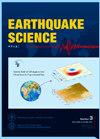Seismic evidence for a thickened mantle transition zone beneath the Kamchatka subduction zone
IF 4.1
4区 地球科学
Q3 Earth and Planetary Sciences
引用次数: 0
Abstract
The structures of the mantle transition zone (MTZ) are of great significance for studying interactions of the subducted slab and deep mantle and related slab dynamics beneath subduction zones. Here by dense near-source SdP sampling from a large global dataset, we image topographies of transition zone discontinuities such as the 410-km and 660-km discontinuities (410 and 660) beneath the Kamchatka and conduct cross-section comparisons with the seismicity. Compared with the IASP91 model, the 410 exhibits apparent uplifts of 45−65 km with an average of 55 km in a horizontal width of ∼130 km, corresponding to low-temperature anomalies of 750−1083 K with an average of 916 K. In contrast, the 660 shows depressions of 15−37 km with an average of 25 km together with downward deflections in a width of ∼260 km, implying low-temperature anomalies of 161−397 K with an average of 268 K. Thus, we confirm a thickened MTZ with a thickness of 325−345 km around the cold descending Pacific slab. We suggest that topographic patterns of transition zone discontinuities imply a Pacific slab that has been significantly heated in the MTZ with broadened thermal effects on the 660. When considered along with other studies, we infer that the slab is possibly heated by hot mantle flows around the torn slab window extended to at least the MTZ range, thus inducing variations in thermal and rheological properties of the slab. Our seismic results can provide more insight into slab dynamics in the northwestern Pacific.
堪察加俯冲带下增厚地幔过渡带的地震证据
地幔过渡带的构造对于研究俯冲带下俯冲板块与深部地幔的相互作用以及相关的板块动力学具有重要意义。在这里,通过从一个大型全球数据集中密集的近源SdP采样,我们对堪察加半岛410公里和660公里不连续面(410和660)等过渡带不连续面进行了地形成像,并与地震活动进行了截面比较。与IASP91模式相比,410在水平宽度为~ 130 km的范围内表现出45 ~ 65 km的平均55 km的视隆起,对应于750 ~ 1083 K的平均916 K的低温异常。相比之下,660显示出15 ~ 37 km的低压,平均25 km,以及宽度为~ 260 km的向下偏转,这意味着低温异常为161 ~ 397 K,平均为268 K。因此,我们确认在寒冷下降的太平洋板块周围存在厚度为325 ~ 345 km的增厚MTZ。我们认为过渡带不连续性的地形模式暗示太平洋板块在中过渡带被显著加热,在660年代热效应扩大。考虑到其他研究,我们推断,板块可能是被撕裂板块窗口周围的热地幔流加热,至少延伸到MTZ范围,从而导致板块的热学和流变特性发生变化。我们的地震结果可以为西北太平洋的板块动力学提供更多的见解。
本文章由计算机程序翻译,如有差异,请以英文原文为准。
求助全文
约1分钟内获得全文
求助全文
来源期刊

Earthquake Science
GEOCHEMISTRY & GEOPHYSICS-
CiteScore
1.10
自引率
8.30%
发文量
42
审稿时长
3 months
期刊介绍:
Earthquake Science (EQS) aims to publish high-quality, original, peer-reviewed articles on earthquake-related research subjects. It is an English international journal sponsored by the Seismological Society of China and the Institute of Geophysics, China Earthquake Administration.
The topics include, but not limited to, the following
● Seismic sources of all kinds.
● Earth structure at all scales.
● Seismotectonics.
● New methods and theoretical seismology.
● Strong ground motion.
● Seismic phenomena of all kinds.
● Seismic hazards, earthquake forecasting and prediction.
● Seismic instrumentation.
● Significant recent or past seismic events.
● Documentation of recent seismic events or important observations.
● Descriptions of field deployments, new methods, and available software tools.
The types of manuscripts include the following. There is no length requirement, except for the Short Notes.
【Articles】 Original contributions that have not been published elsewhere.
【Short Notes】 Short papers of recent events or topics that warrant rapid peer reviews and publications. Limited to 4 publication pages.
【Rapid Communications】 Significant contributions that warrant rapid peer reviews and publications.
【Review Articles】Review articles are by invitation only. Please contact the editorial office and editors for possible proposals.
【Toolboxes】 Descriptions of novel numerical methods and associated computer codes.
【Data Products】 Documentation of datasets of various kinds that are interested to the community and available for open access (field data, processed data, synthetic data, or models).
【Opinions】Views on important topics and future directions in earthquake science.
【Comments and Replies】Commentaries on a recently published EQS paper is welcome. The authors of the paper commented will be invited to reply. Both the Comment and the Reply are subject to peer review.
 求助内容:
求助内容: 应助结果提醒方式:
应助结果提醒方式:


